Downdip Development of the Ni-Cu-PGE-Bearing Mafic to Ultramafic Uitkomst Complex, Mpumalanga Province, South Africa
Abstract
:1. Introduction
1.1. Previous Work
1.2. Geological Setting of the Uitkomst Complex
1.3. Downdip Development of the Complex
2. Materials and Methods
LA-ICP-MS U–Th–Pb Dating
3. Results
3.1. Lithologies and Petrography of the Complex at LM-6
3.2. Geochemical and Mineral Chemistry Trends in LM-6
3.3. Alteration and Contact Metamorphism
3.4. Ore Mineralisation at Little Mamre
3.5. Zircon Dating
4. Discussion
4.1. Mineralogy and Geochemistry Reflecting Magmatic System Conditions
4.2. Alteration and Contact Metamorphism
4.3. Mineralisation
4.4. Age of the Uitkomst Complex
5. Conclusions
- The first complete intersection of the complex at LM supports lithological and mineralogical continuity and an increase in thickness of the Main Harzburgite and Gabbronorite units in the downdip extension compared to the intersections on UK and SH (e.g., drillhole SH176). The Chromitiferous Harzburgite unit contains less and thinner massive chromitite layers, whereas the Main Harzburgite unit displays layers of pegmatoidal rocks in its central and upper parts.
- The shallowly dipping trough to sill-like intrusive body continues bedding parallel towards northwest without signs of plunging into a subvertical feeder channel. Mineralogical and lithogeochemical trends in LM-6 are similar to previous intersections; their consistency in the MHZG unit supports a model that magma surges replenished the conduit with magma of almost constant composition. Zircon saturation temperatures calculated for the observed major-element data and Zr concentrations showed a minor increase for the Basal Gabbro chilled margin from UK to LM, but a significant decrease from the margins to the centre.
- Chromite compositions of the Main Harzburgite unit at LM are more Cr- and Al-rich than at UK and chemically less evolved than Bushveld Complex Merensky Reef chromites, reflecting the deeper part of the conduit. The upwards increasing Mg#, Cr/Fe and Cl/(Cr + Al) and decreasing TiO2 trends may indicate a formation by magma replenishment similar to formation mechanisms suggested for podiform and komatiite-hosted chromitites.
- Late-magmatic apatite, titanite and zircon in pegmatoidal portions of ultramafic and in mafic rocks originated from an evolved, H2O-rich late-stage melt as part of the differentiation sequence. Apatite compositional heterogeneity reveals a complex history of magma mixing with at least two components and crystallisation over short timescales. Carbonatic fluids probably contributed to the formation of titanite from the Ti-bearing melt and magmatic ilmenite.
- “Autometamorphic” fluids derived from contact metamorphism of pelitic and carbonate rocks caused pervasive hydrothermal (deuteric) alteration such as serpentinsation, talc-carbonation, uralitisation and saussuritisation, affecting both mafic and ultramafic units. S-bearing fluids produced secondary pyrite overgrowth, which deteriorates flotation results. Common coatings of talc and mica particles on sulphide minerals have also an opposing effect on the flotation process.
- Ore mineral remobilisaton and alteration, as well as hydrated silicate growth into sulphides promotes multiple mineral intergrowth and decrease of grain size diameters, negatively affecting pentlandite and chalcopyrite liberation.
- U–Pb dating of zircon from the Lower Pyroxenite Unit indicates intercumulus melt crystallisation within the Uitkomst Complex at 2055.0 ± 5.3 Ma, coeval to the Bushveld Complex, suggesting that mafic rocks of both complexes form part of the same magmatic event.
- The intrusion of ultramafic magma into carbonate rocks is considered to represent a highly prospective environment for the formation of magmatic Ni-Cu-PGE-Cr deposits. Ideal situations are host-rock-concordant feeder channels along the Mpumalanga escarpment at the elevation of the Malmani dolomite.
Supplementary Materials
Author Contributions
Funding
Acknowledgments
Conflicts of Interest
Appendix A
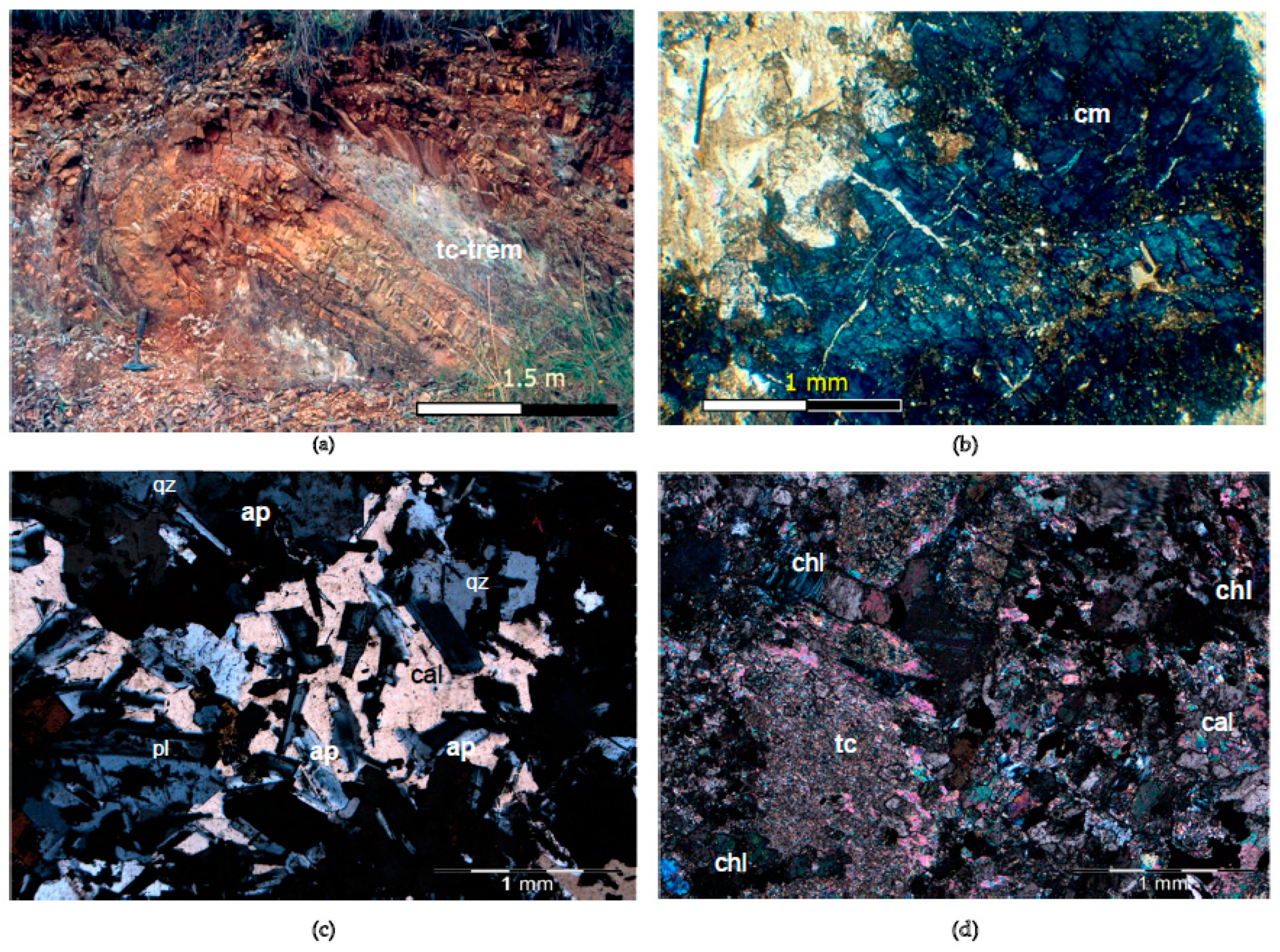
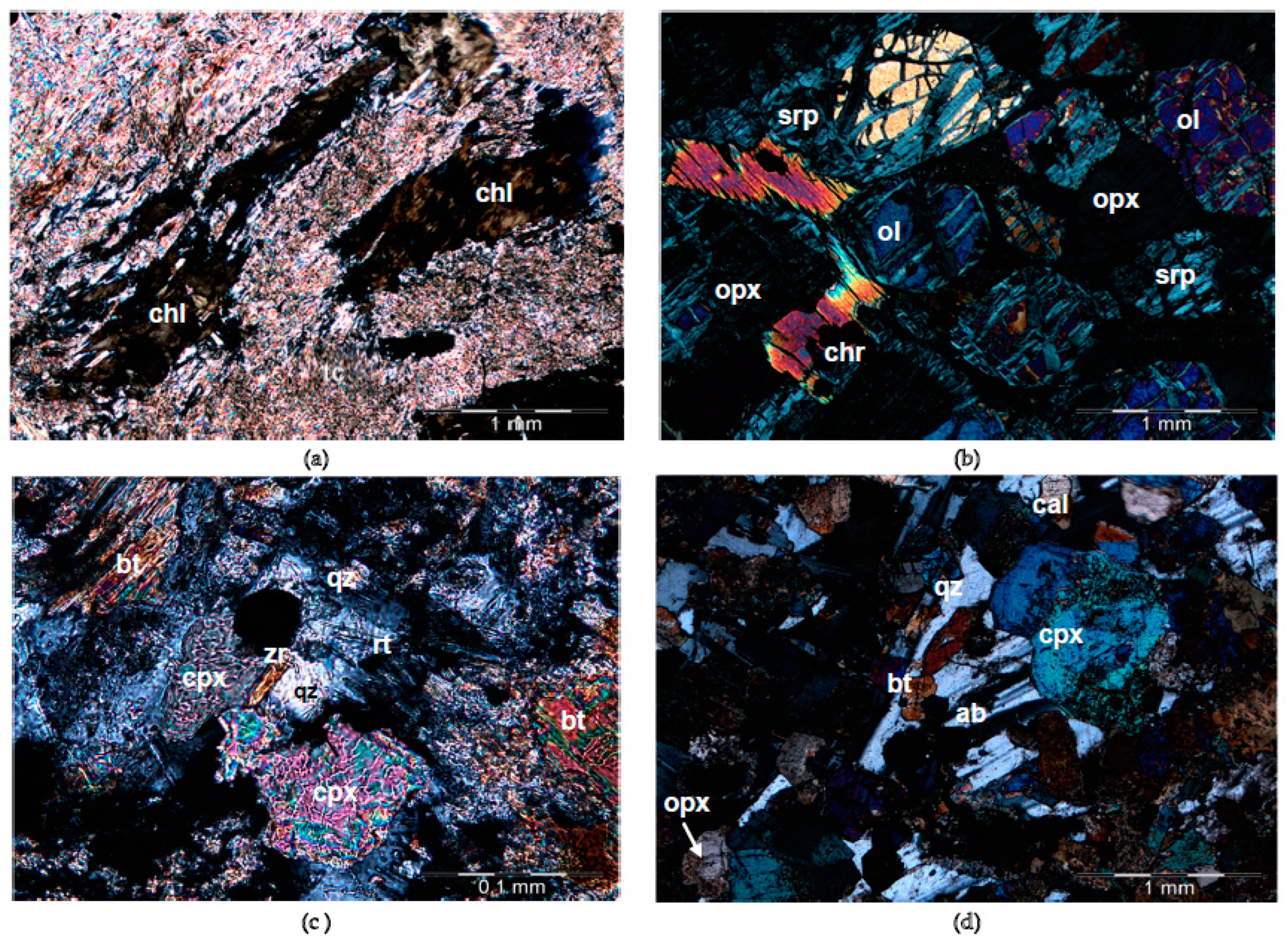


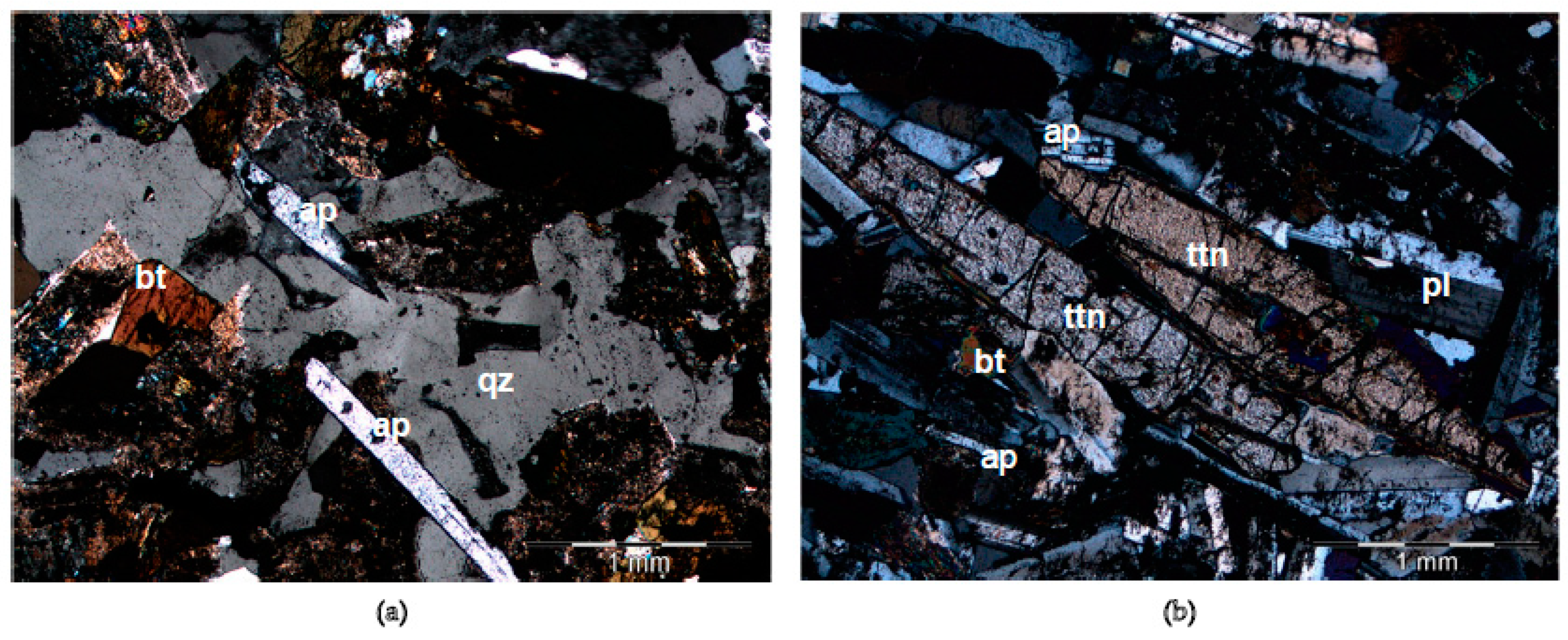

References
- African Rainbow Minerals Pty Ltd. Mineral Resources and Mineral Reserves Report. 2020. Available online: https://arm.co.za/wp-content/uploads/2020/11/Mineral-Reosurces-aand-Reserves-2020-2.pdf (accessed on 7 October 2021).
- Gauert, C.; De Waal, S.; Wallmach, T. Geology of the ultrabasic to basic Uitkomst complex, eastern Transvaal, South Africa: An overview. J. Afr. Earth Sci. 1995, 21, 553–570. [Google Scholar] [CrossRef]
- Gauert, C.D.K. The Petrogenesis of the Uitkomst Complex, Mpumalanga Province, South Africa. Ph.D. Thesis, University of Pretoria, Pretoria, South Africa, 1998. [Google Scholar]
- Kirste, J. Reconstruction of Contact Metamorphism of the Uitkomst Complex, Near Badplaas, Mpumalanga Province, South Africa, Based on Mineralogical and Petrological Investigation of the Contact Aureole. Master’s Thesis, University of the Free State, Bloemfontein, South Africa, 2009. [Google Scholar]
- Trubač, J.; Ackerman, L.; Gauert, C.; Ďurišová, J.; Hrstka, T. Platinum-Group Elements and Gold in Base Metal Sulfides, Platinum-Group Minerals, and Re-Os Isotope Compositions of the Uitkomst Complex, South Africa. Econ. Geol. 2018, 113, 439–461. [Google Scholar] [CrossRef]
- Kenyon, A.K.; Attridge, R.L.; Coetzee, G.L. The Uitkomst nickel-copper deposit, Eastern Transvaal. In Mineral Deposits of Southern Africa; Anhaeusser, C.R., Maske, S., Eds.; Geological Society of South Africa: Johannesburg, South Africa, 1986; Volume 2, pp. 1009–1017. [Google Scholar]
- Von Scheibler, W.H.T.M.; Cawthorn, R.G.; Kenyon, A.K.; Allen, I.V.M. Ni–Cu Sulfide Mineralization in the Uitkomst Intrusion. In Centennial Geocongress (1995): Rand Afrikaans University (RAU) Johannesburg, South Africa 3rd–7th April 1995. Extended abstracts. Vol. 1 and Vol. II; Geological Society of South Africa: Johannesburg, South Africa, 1995; pp. 133–136. [Google Scholar]
- Gauert, C.D.K.; Jordaan, L.J.; de Waal, S.A.; Wallmach, T. Isotopic constraints on the source of sulphur for the base metal sulphides of the Uitkomst Complex, Badplaas, South Africa. S. Afr. J. Geol. 1996, 99, 41–50. [Google Scholar]
- Van Zyl, A.M. The Sulphides of the Uitkomst Complex, Badplaas, South Africa. Master’s Thesis, University of Pretoria, Pretoria, South Africa, 1996. [Google Scholar]
- Gauert, C. Sulphide and oxide mineralisation in the Uitkomst Complex, South Africa: Origin in a magma conduit. J. Afr. Earth Sci. 2001, 32, 149–161. [Google Scholar] [CrossRef]
- De Waal, S.A.; Gauert, C.D.K. The Basal Gabbro Unit and the identity of the parental magma of the Uitkomst Complex, Badplaas, South Africa. S. Afr. J. Geol. 1997, 100, 349–361. Available online: https://hdl.handle.net/10520/EJC-92d9c7621 (accessed on 18 December 2021).
- De Waal, S.A.; Maier, W.D.; Armstrong, R.A.; Gauert, C.D. Parental magma and emplacement of the stratiform Uitkomst Complex, South Africa. Can. Miner. 2001, 39, 557–571. [Google Scholar] [CrossRef] [Green Version]
- Hornsey, A.E. The Genesis and Evolution of Nkomati Mine Ni-Sulfide Deposit, Mpumalanga Province. Master’s Thesis, University of Natal, Durban, South Africa, 1999. [Google Scholar]
- Maier, W.D.; Gomwe, T.; Barnes, S.-J.; Li, C.; Theart, H. Platinum Group Elements in the Uitkomst Complex, South Africa. Econ. Geol. 2004, 99, 0499–516. [Google Scholar] [CrossRef]
- Maier, W.D.; Prevec, S.; Scoates, J.; Wall, C.; Barnes, S.-J.; Gomwe, T.S. The Uitkomst intrusion and Nkomati Ni-Cu-Cr-PGE deposit, South Africa: Trace element geochemistry, Nd isotopes and high-precision geochronology. Miner. Deposita 2017, 53, 67–88. [Google Scholar] [CrossRef] [Green Version]
- Li, C.; Ripley, E.; Maier, W.; Gomwe, T. Olivine and sulfur isotopic compositions of the Uitkomst Ni–Cu sulfide ore-bearing complex, South Africa: Evidence for sulfur contamination and multiple magma emplacements. Chem. Geol. 2002, 188, 149–159. [Google Scholar] [CrossRef]
- Gomwe, T. A Geochemical Profile through the Uitkomst Complex on the Farm Slaaihoek, with Special Reference to the Platinum-Group Elements and Sm-Nd Isotopes. Master’s Thesis, University of Pretoria, Pretoria, South Africa, 2002. [Google Scholar]
- Theart, H.F.J.; de Nooy, C.D. The Platinum Group Minerals in two parts of the Massive Sulphide Body of the Uitkomst Complex, Mpumalanga, South Africa. S. Afr. J. Geol. 2003, 104, 287–300. [Google Scholar] [CrossRef]
- Hulley, V. Reactions between Country Rock Xenoliths and the Magma of the Uitkomst Complex, with Implications for the Origin of the Sulphide Mineralisation. Master’s Thesis, University of Pretoria, Pretoria, South Africa, 2005. [Google Scholar]
- Sarkar, A.; Ripley, E.M.; Li, C.; Maier, W.D. Stable isotope, fluid inclusion, and mineral chemistry constraints on contamination and hydrothermal alteration in the Uitkomst Complex, South Africa. Chem. Geol. 2008, 257, 129–138. [Google Scholar] [CrossRef]
- Steenkamp, N.C. Alteration Assemblage in the Lower Units of the Uitkomst Complex, Mpumalanga Province, South Africa. Ph.D. Thesis, University of Pretoria, Pretoria, South Africa, 2012. [Google Scholar]
- Yudovskaya, M.A.; Naldrett, A.J.; Woolfe, J.A.S.; Costin, G.; Kinnaird, J.A. Reverse Compositional Zoning in the Uitkomst Chromitites as an Indication of Crystallization in a Magmatic Conduit. J. Pet. 2015, 56, 2373–2394. [Google Scholar] [CrossRef] [Green Version]
- Wabo, H.; Olsson, J.; de Kock, M.; Humbert, F.; Söderlund, U.; Klausen, M.B. New U–Pb age and paleomagnetic constraints from the Uitkomst Complex, South Africa: Clues to the timing of intrusion. GFF 2016, 138, 152–163. [Google Scholar] [CrossRef]
- Gerdes, A.; Zeh, A. Combined U–Pb and Hf isotope LA-(MC-)ICP-MS analyses of detrital zircons: Comparison with SHRIMP and new constraints for the provenance and age of an Armorican metasediment in Central Germany. Earth Planet. Sci. Lett. 2006, 249, 47–61. [Google Scholar] [CrossRef]
- Gerdes, A.; Zeh, A. Zircon formation versus zircon alteration — New insights from combined U–Pb and Lu–Hf in-situ LA-ICP-MS analyses, and consequences for the interpretation of Archean zircon from the Central Zone of the Limpopo Belt. Chem. Geol. 2009, 261, 230–243. [Google Scholar] [CrossRef]
- Zeh, A.; Gerdes, A. U-Pb and Hf isotope record of detrital zircons from gold-bearing sediments of the Pietersburg Greenstone Belt (South Africa)—Is there a common provenance with the Witwatersrand Basin? Precambrain Res. 2012, 204, 46–56. [Google Scholar] [CrossRef]
- Stacey, J.S.; Kramers, J.D. Approximation of terrestrial lead isotope evolution by a two-stage model. Earth Planet. Sci. Lett. 1975, 26, 207–221. [Google Scholar] [CrossRef]
- Jackson, S.E.; Paerson, N.J.; Griffin, W.L.; Belousova, E.A. The application of laser ablation-inductively coupled plasma-mass spectrometry to in-situ U-Pb zircon geochronology. Chem. Geol. 2004, 211, 47–69. [Google Scholar] [CrossRef]
- Sláma, J.; Košler, J.; Condon, D.J.; Crowley, J.L.; Gerdes, A.; Hanchar, J.M.; Horstwood, M.S.A.; Morris, G.A.; Nasdala, L.; Norberg, N.; et al. Plešovice zircon—A new natural reference material for U–Pb and Hf isotopic microanalysis. Chem. Geol. 2008, 249, 1–35. [Google Scholar] [CrossRef]
- Zeh, A.; Ovtcharova, M.; Wilson, A.H.; Schaltegger, M. The Bushveld Complex was emplaced and cooled in less than one million years–results of zirconology, and geotectonic implications. Earth Planet. Sci. Lett. 2015, 418, 103–114. [Google Scholar] [CrossRef]
- Ludwig, K. Users Manual for Isoplot/Ex, rev. 2.49: A Geochronological Toolkit for Microsoft Excel; Berkeley Geochronology Center Special Publication: Berkeley, CA, USA, 2001; Volume 1a, pp. 1–55. [Google Scholar]
- Harmer, R.E.; Sharpe, M.R. Field relations and strontium isotope systematics of the marginal rocks of the eastern Bushveld Complex. Econ. Geol. 1985, 80, 813–837. [Google Scholar] [CrossRef]
- Barnes, S.J. Spincalc_dec04. 2004. Available online: http://www.em.csiro.au/terrain_studies/aboutus/people/stephen_barnes/spincalc_dec04.xls (accessed on 21 February 2020).
- Cockburn, G. Challenges and Successes at the Nkomati Nickel JV: Pit-to-Product Process Improvements. In Proceedings of the The Southern African Institute of Mining and Metallurgy Base Metals Conference 2013 Abstracts, Sun City, South Africa, 28–30 September 2009; pp. 151–167. [Google Scholar]
- Boehnke, P.; Watson, E.B.; Trail, D.; Harrison, T.M.; Schmitt, A.K. Zircon saturation re-revisited. Chem. Geol. 2013, 351, 324–334. [Google Scholar] [CrossRef]
- Watson, E.B.; Harrison, T.M. Zircon saturation revisited: Temperature and composition effects in a variety of crustal magma types. Earth Planet. Sci. Lett. 1983, 64, 295–304. [Google Scholar] [CrossRef]
- Boyce, J.W.; Hervig, R.L. Apatite as a monitor of late-stage magmatic processes at Volcán Irazú, Costa Rica. Contrib. Mineral. Petrol. 2009, 157, 135–145. [Google Scholar] [CrossRef]
- Colwell, L.E.; John, B.E.; Cheadle, M.J.; Wooden, J.L. Chemistry of titanite (sphene) in ocean crust: A tool for understanding late-stage igneous and metasomatic processes at mid-ocean ridges. In AGU Fall Meeting Abstracts; American Geophysical Union: Washington, DC, USA, 2011. [Google Scholar]
- Joubert, L.P. Syn- to Post-Intrusive Deformation in the Chromitiferous Harzburgite Unit of the Uitkomst Complex, Nkomati Mine, Mpumalanga Province. Master’s Thesis, University of the Free State, Bloemfontein, South Africa, 2013. [Google Scholar]
- Barnes, S.J.; Hill, R.E.T. Metamorphism of Komatiite-Hosted Nickel Sulfide Deposits. In Metamorphic and Metamorphogenic Ore Deposits; Vokes, F.M., Marshall, B., Spry, P.G., Eds.; Society of Economic Geologists: Littleton, CO, USA, 1998; Volume 11, pp. 203–215. [Google Scholar]
- Merlini, A.; Grieco, G.; Diella, V. Ferritchromite and chromian-chlorite formation in melange-hosted Kalkan chromitite (Southern Urals, Russia). Am. Miner. 2009, 94, 1459–1467. [Google Scholar] [CrossRef]
- Colás, V.; Gervilla, F.; Fanlo, I.; Kerestedjian, T.N.; Sergeeva, I.; Gonzalez-Jimenez, J.M.; Arranz, E. Factors Controlling Chromite Alteration: Example from Costurino, SE Bulgaria. Rev. Soc. Españ Miner. 2012, 16, 238–239. [Google Scholar]
- Mishra, G.; Viljoen, K.; Mouri, H. Influence of mineralogy and ore texture on pentlandite flotation at the Nkomati nickel mine, South Africa. Miner. Eng. 2013, 54, 63–78. [Google Scholar] [CrossRef]
- Gudelius, D.; Zeh, A.; Almeev, R.; Wilson, A.; Fischer, L.; Schmitt, A. Zircon melt inclusions in mafic and felsic rocks of the Bushveld Complex—Constraints for zircon crystallization temperatures and partition coefficients. Geochim. Cosmochim. Acta 2020, 289, 158–181. [Google Scholar] [CrossRef]
- Gudelius, D.; Zeh, A.; Wilson, A. Zircon formation in mafic and felsic rocks of the Bushveld Complex, South Africa: Constraints from composition, zoning, Th/U ratios, morphology, and modelling. Chem. Geol. 2020, 546, 119647. [Google Scholar] [CrossRef]
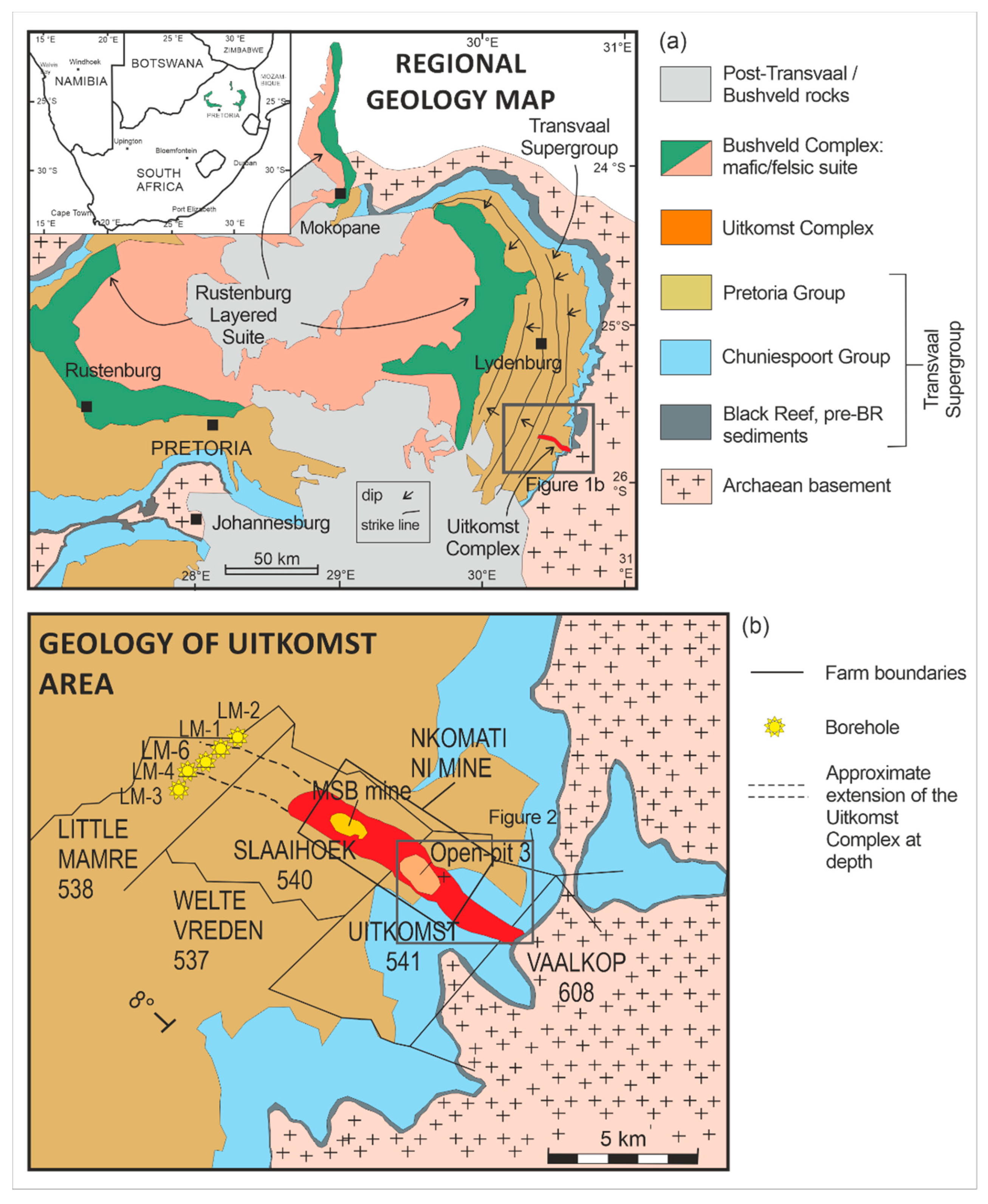
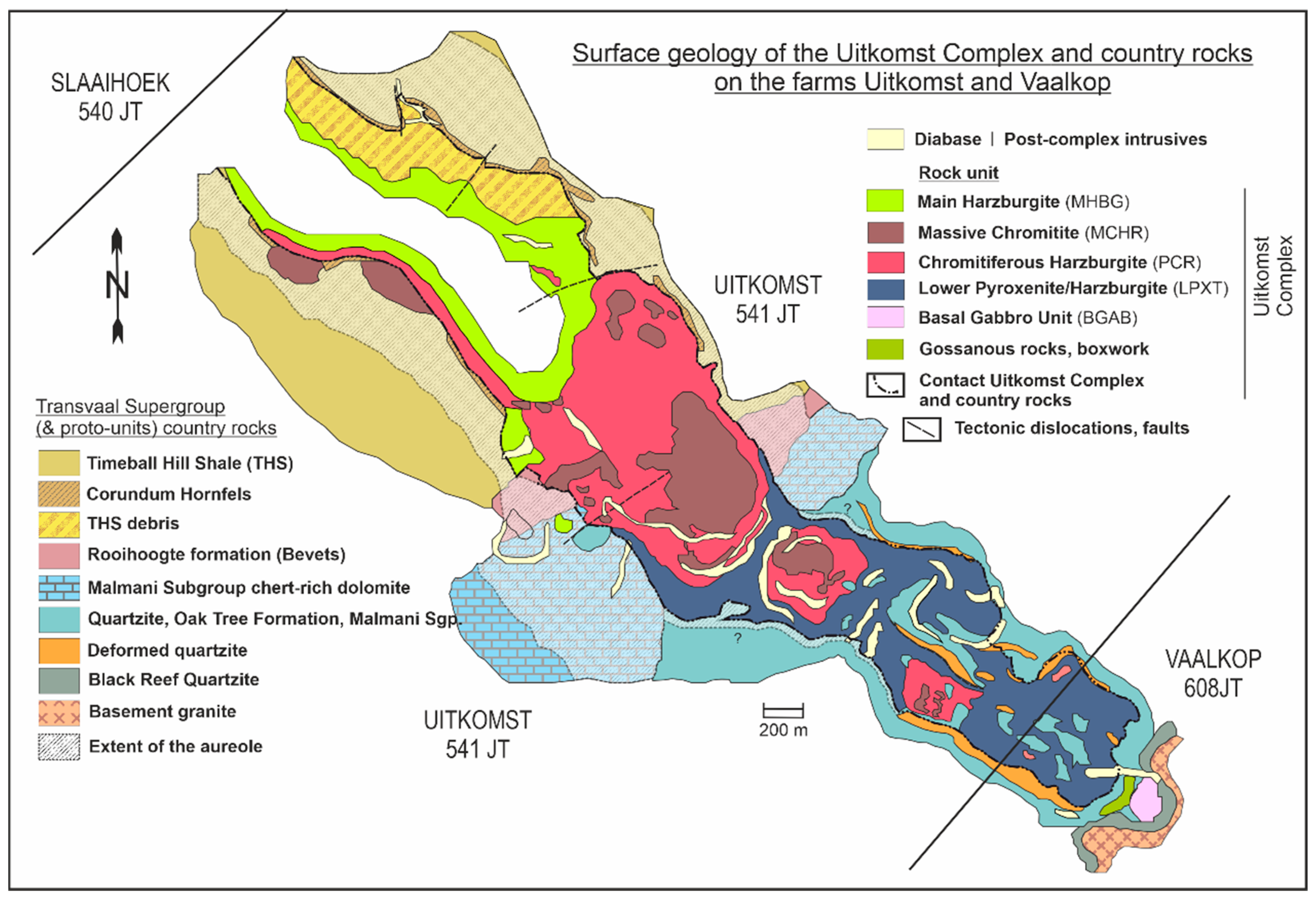
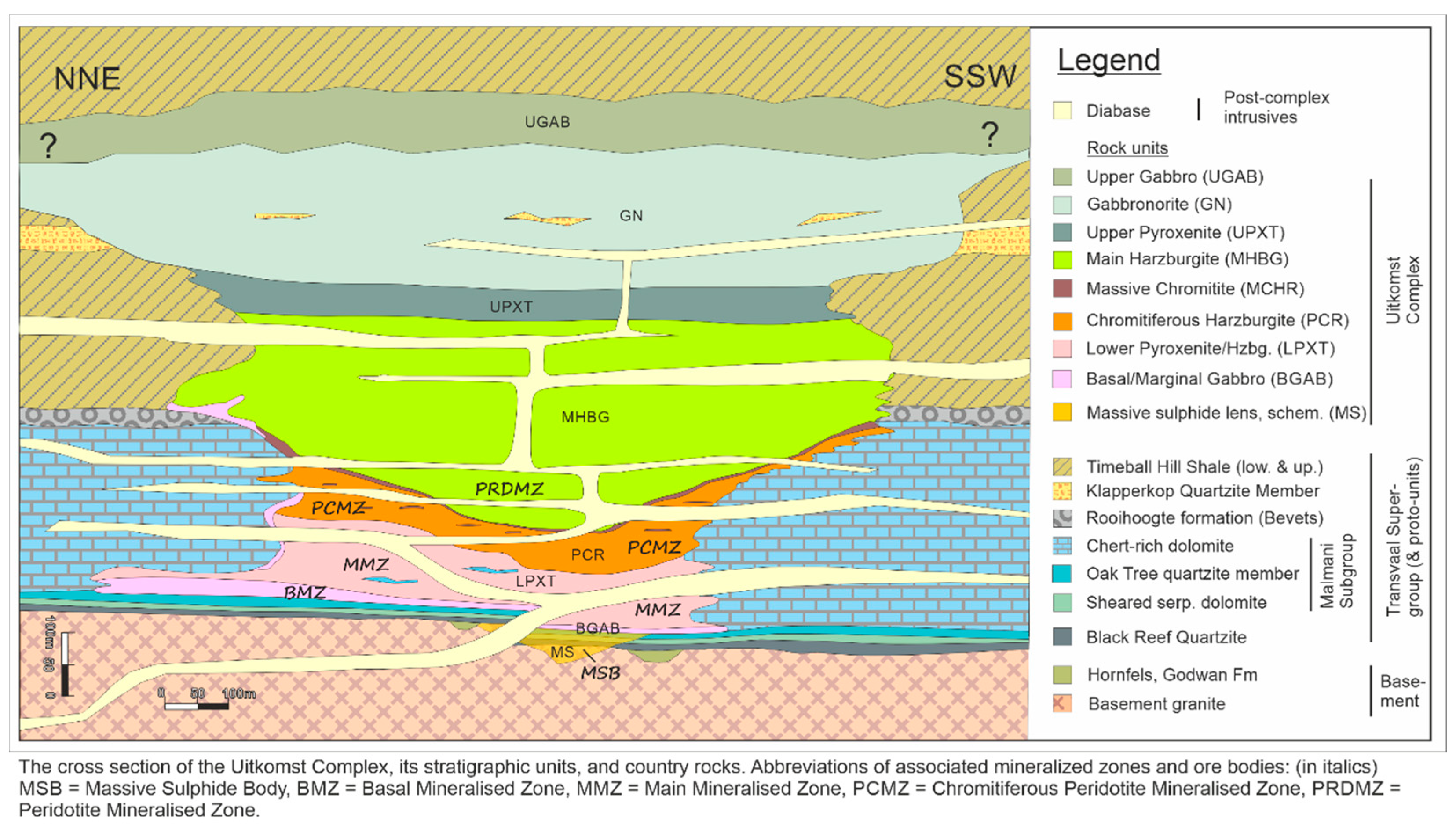
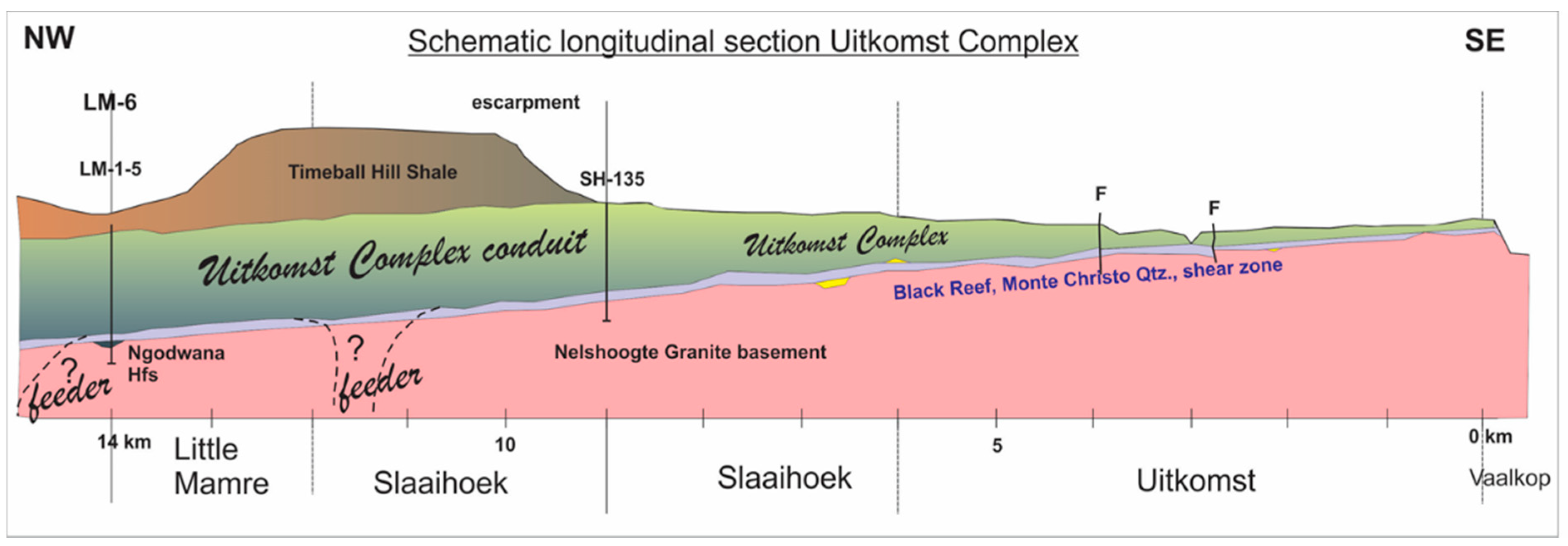



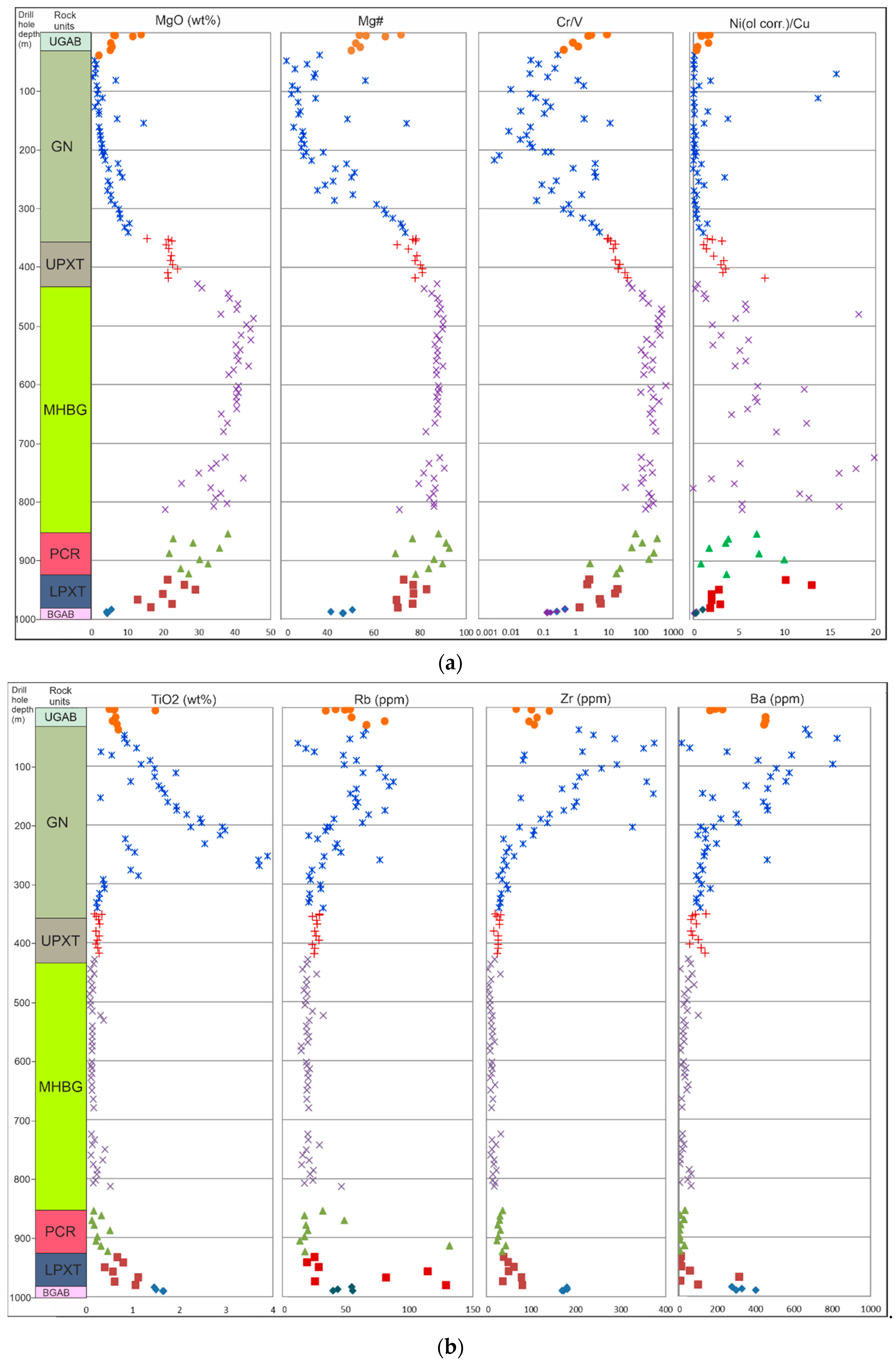

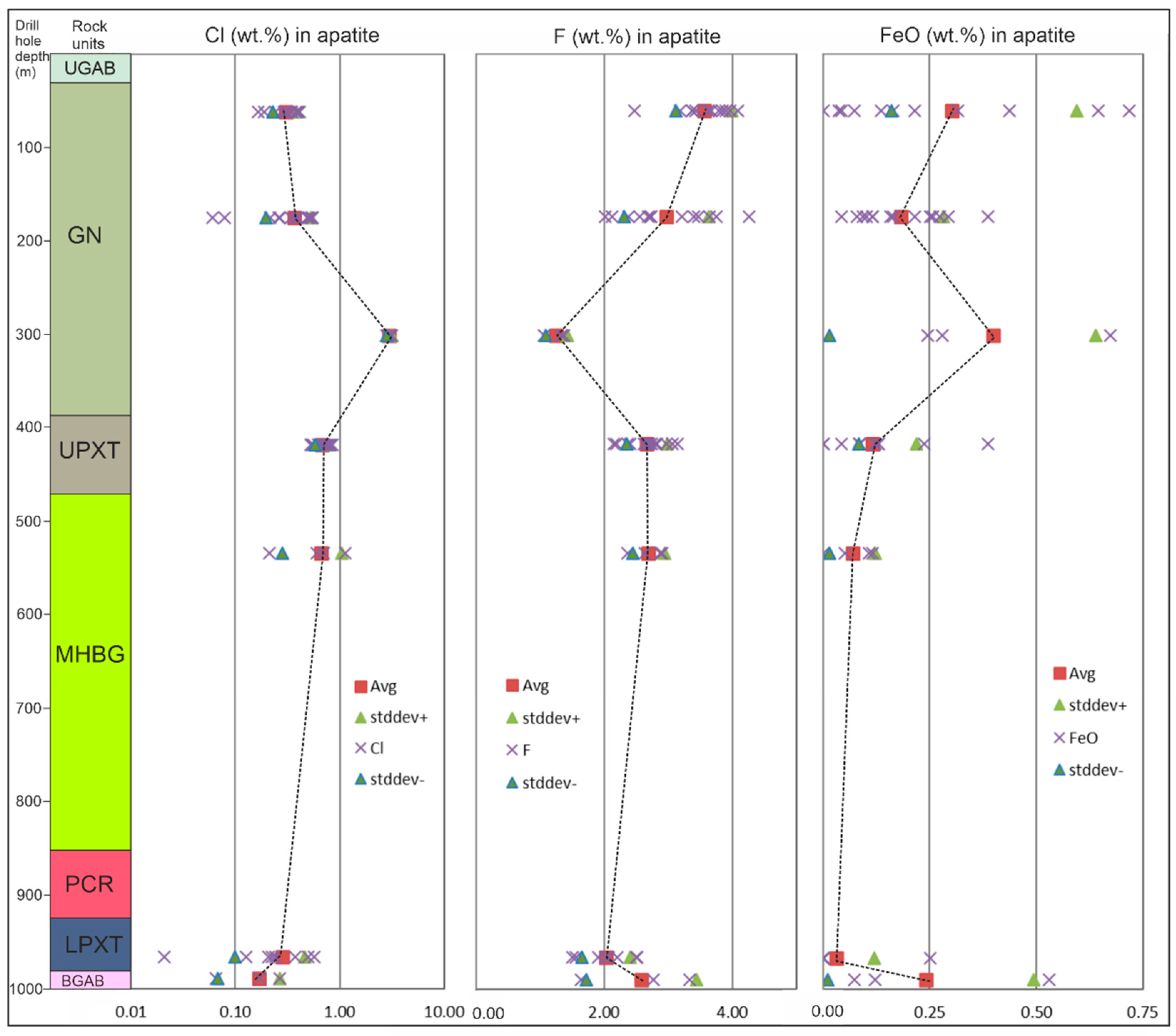
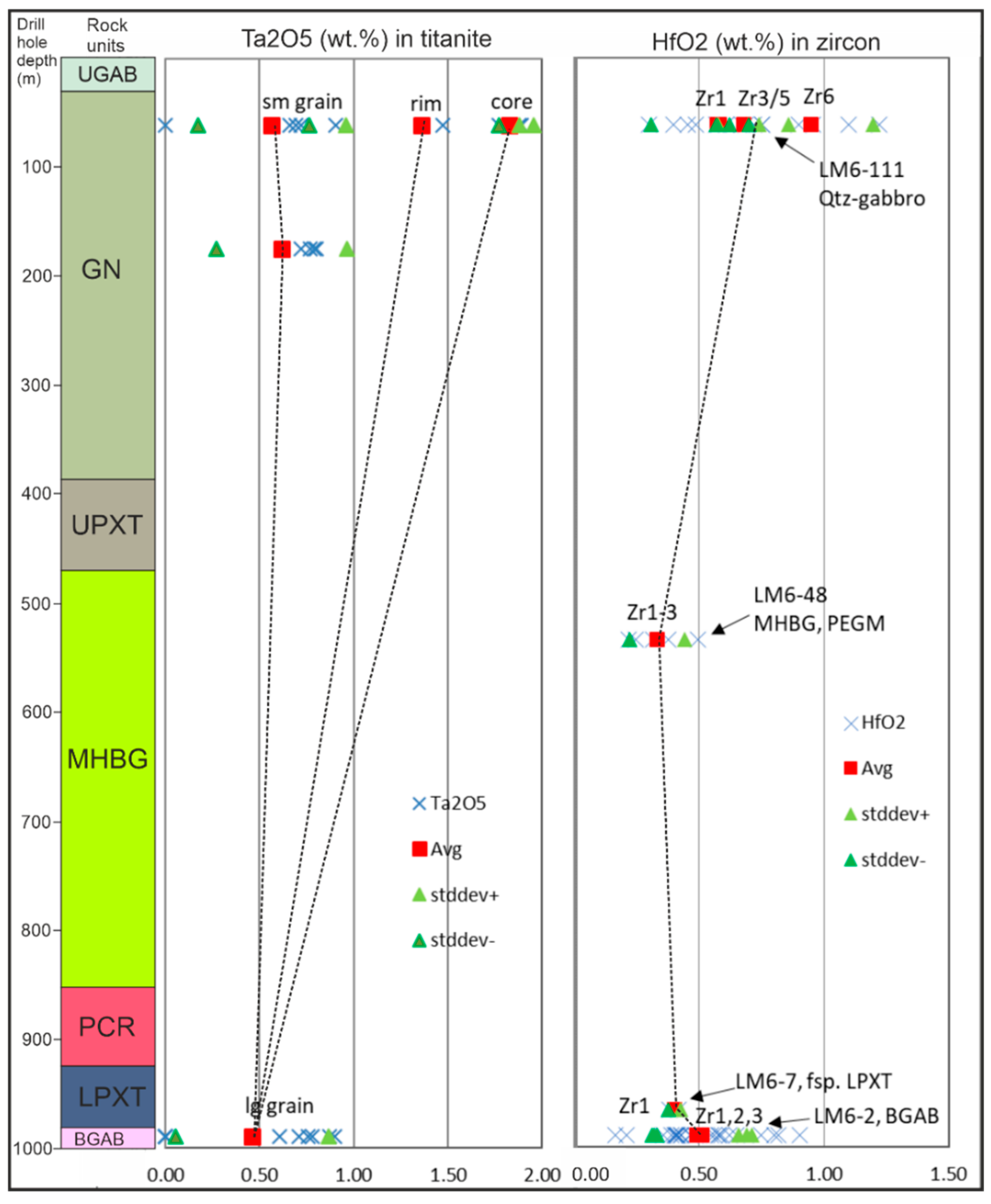
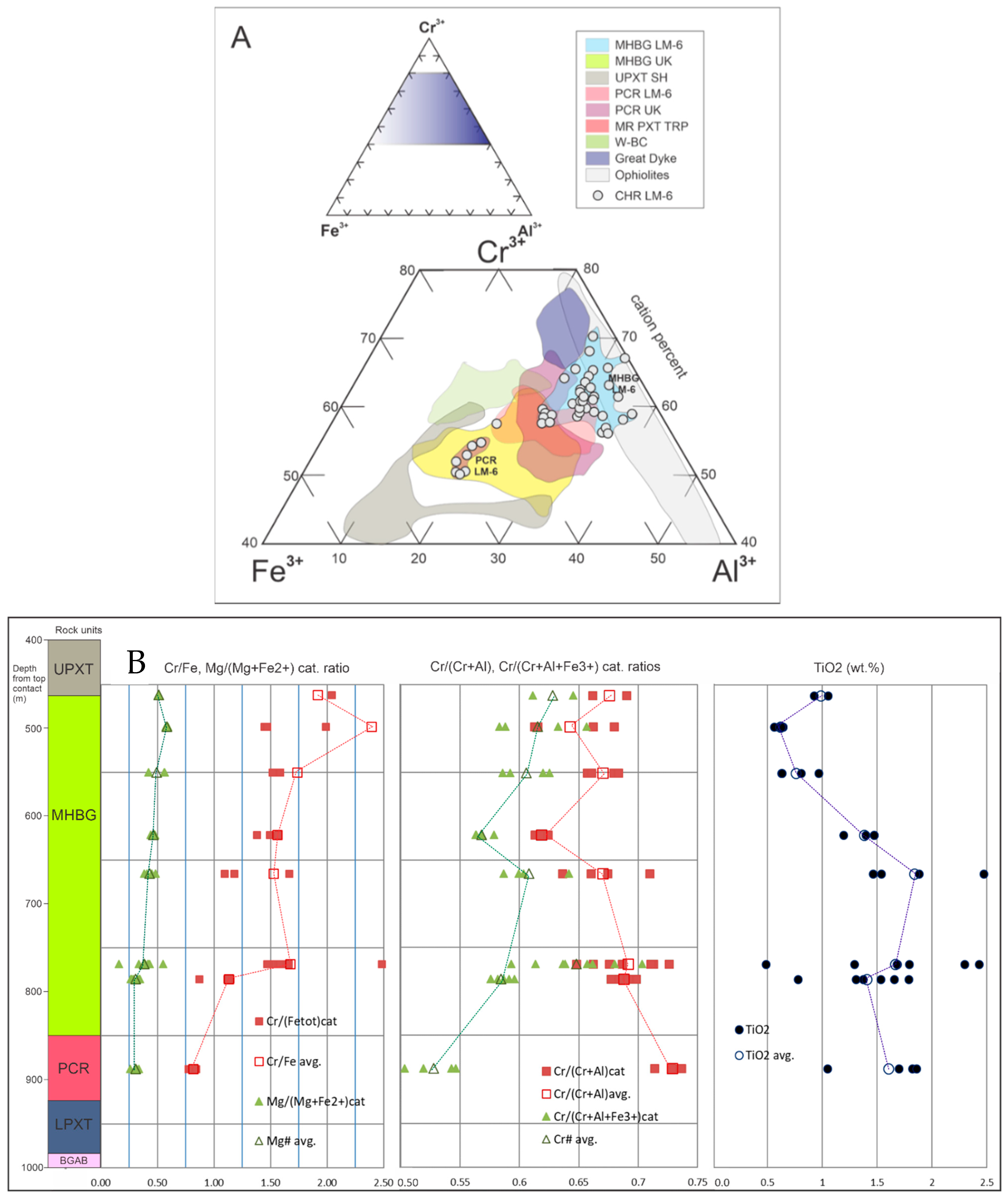
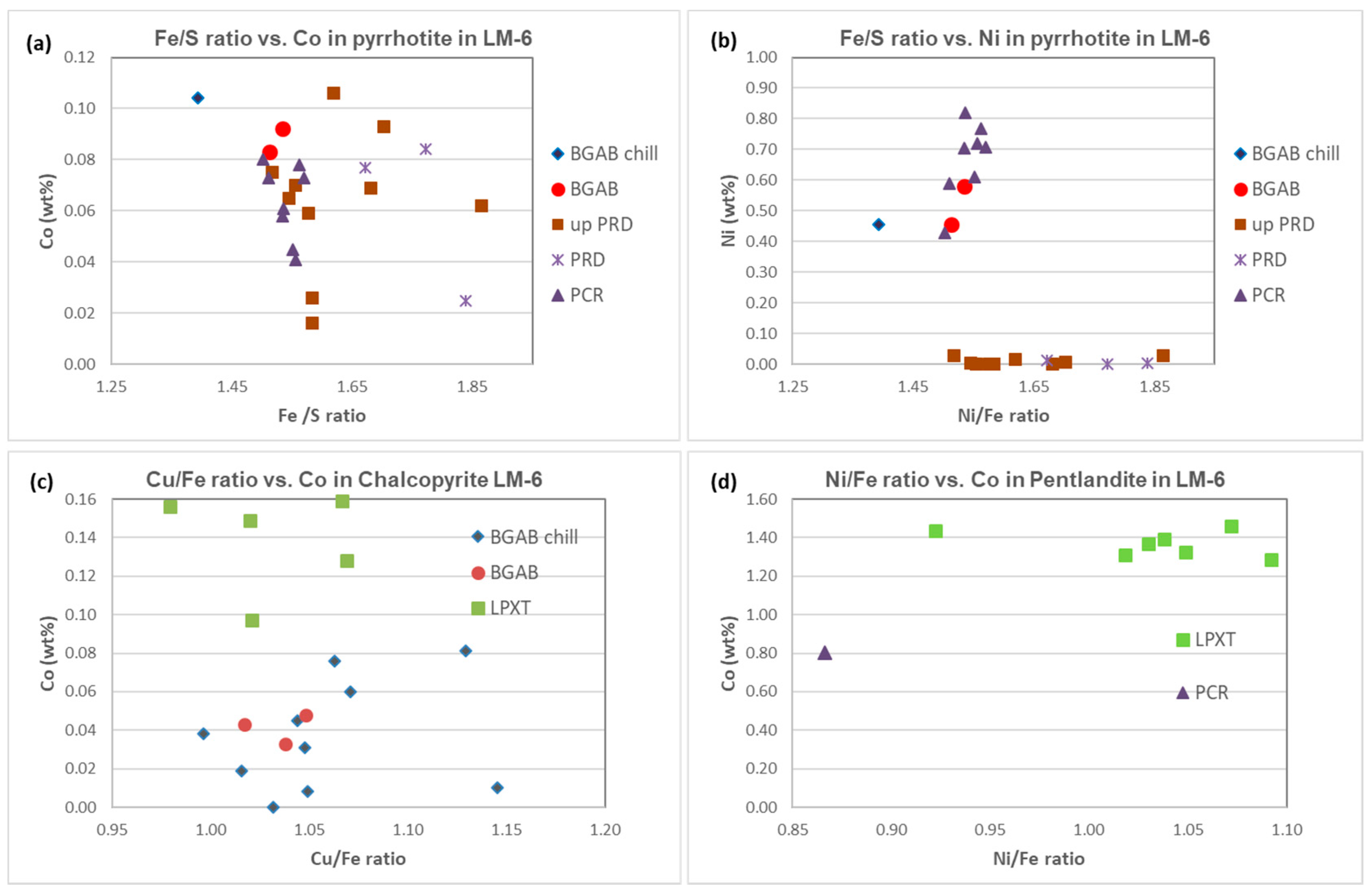
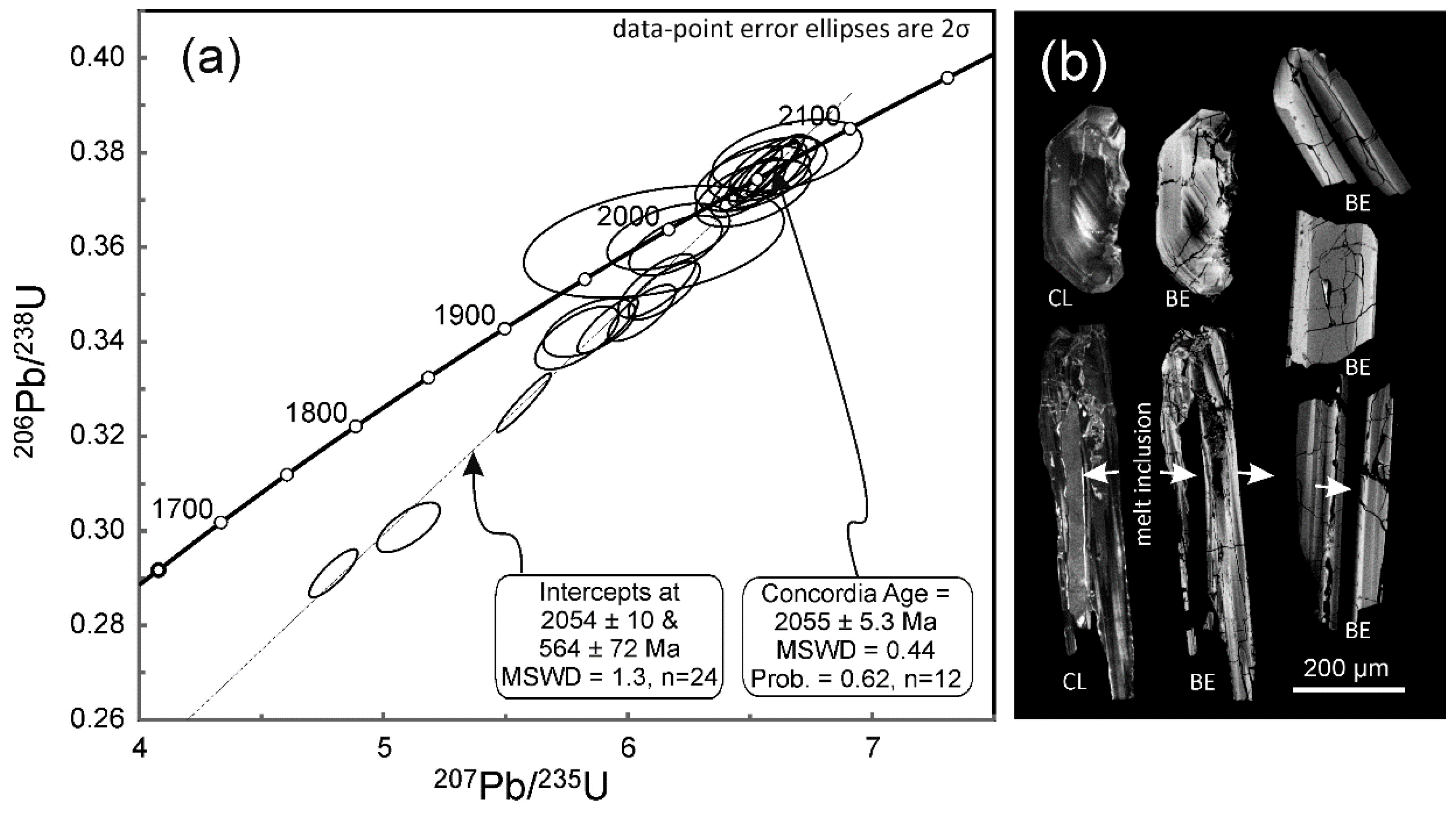
Publisher’s Note: MDPI stays neutral with regard to jurisdictional claims in published maps and institutional affiliations. |
© 2021 by the authors. Licensee MDPI, Basel, Switzerland. This article is an open access article distributed under the terms and conditions of the Creative Commons Attribution (CC BY) license (https://creativecommons.org/licenses/by/4.0/).
Share and Cite
Gauert, C.; Zeh, A. Downdip Development of the Ni-Cu-PGE-Bearing Mafic to Ultramafic Uitkomst Complex, Mpumalanga Province, South Africa. Minerals 2022, 12, 22. https://doi.org/10.3390/min12010022
Gauert C, Zeh A. Downdip Development of the Ni-Cu-PGE-Bearing Mafic to Ultramafic Uitkomst Complex, Mpumalanga Province, South Africa. Minerals. 2022; 12(1):22. https://doi.org/10.3390/min12010022
Chicago/Turabian StyleGauert, Christoph, and Armin Zeh. 2022. "Downdip Development of the Ni-Cu-PGE-Bearing Mafic to Ultramafic Uitkomst Complex, Mpumalanga Province, South Africa" Minerals 12, no. 1: 22. https://doi.org/10.3390/min12010022
APA StyleGauert, C., & Zeh, A. (2022). Downdip Development of the Ni-Cu-PGE-Bearing Mafic to Ultramafic Uitkomst Complex, Mpumalanga Province, South Africa. Minerals, 12(1), 22. https://doi.org/10.3390/min12010022




